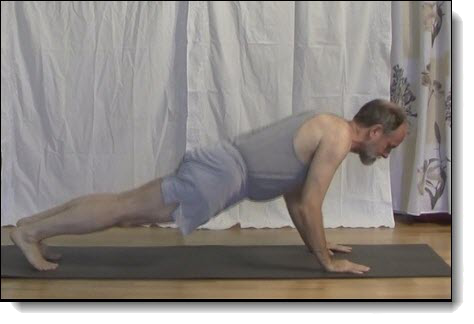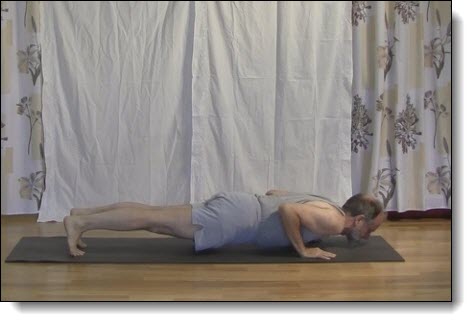One of the biggest problems people have when they start an Ashtanga based yoga practice is that it is impossible for them to do Chaturanga Dandasana. This is very bad news, because Chaturanga Dandasana is done a whole lot of times during one Ashtanga yoga practice.
Chaturanga Dandasana requires a great deal of upper body strength. The best most people can do is to crash on the floor without any control or let there body sag down towards the floor as they struggle to get their body lowered down. Both of these approaches will result in injury and frustration.
There is a way to modify the pose so that you can develop your upper body strength without injury. These modifications will also help to reduce your frustration.
What is Chaturanga Dandasana
Chaturanga Dandasana is also know as four limbed stick because it looks like a stick with four very short limbs touching the floor. When done properly only the hands and the feet are on the floor and the body is in a straight line only inches from the floor.
It is very similar to a regular push up with a few differences. The similarity is that your body is flat, you are hovering just off of the floor and only your hands and toes touching the floor.
The differences are that your elbows are in by your side and there is a short space between your feet. Now lets look at how to do Chaturanga Dandasana.
How to do Chaturanga Dandasana
You start in high plank.
As you can see in the first picture above, your start with arms straight, your hands are shoulder width apart and they are under your shoulders. Your hands are flat to the floor, pointing straight ahead and your fingertips are under your shoulders.
Your body is a straight line from your head, through your shoulders and hips and on to your heels. There is a space of about 6 to 8 inches between your feet, your toes are tucked in and your heels are pointing towards the ceiling.
This is the starting position. Now comes the really challenging part.
Next you lower down towards the floor by bending your elbows back towards your feet.
Stop lowering down when your elbows and shoulders are at the same height from the floor.
Your gaze is down the nose towards the floor.
This is all well and good if you have lots of upper body strength. If you are lacking in upper body strength you will find it very difficult or impossible to do this pose. Lowering with control towards the floor and hovering above the floor will be impossible unless you have lots of upper body strength. Yet you can use this pose to help you to develop your upper body strength. Let’s have a look at those modifications.
How to develop your upper body strength
The usual problem with Chaturanga Dandasana is the lack of strength in your shoulders and abdomen prevents you from lowering with control towards the floor.
There are several stages that you go through to develop your upper body strength in this pose.
- drop the knees
- control the fall
- hover for an instant
You work through each of these stages in turn. When you are able to do one stage successfully then it is time to move on to the next stage. Let’s start at the beginning with Stage 1 – Drop the knees.
Stage 1 – Drop the knees
You start in high plank.
Before you start to lower down, drop your knees to the floor.
Now bend the elbows back and start lowering your body to the floor. With your knees on the floor it should be a lot easier to lower down to the floor with control.
You are not trying to hover off of the floor in this stage. You are working on lowering your upper body with control to the floor.
Overtime you will develop some strength in your shoulders and abdomen. When this stage becomes easy it is time to move on to stage 2 – control the fall.
Stage 2 – Control the fall
You start in high plank as before.
This time keep the knees off of the floor. Keep your body straight and bend your elbows back and start lowering yourself towards the floor.
If you find that your hips are sagging towards the floor then you should go back to Stage 1 – Drop the knees. It is not yet time for this stage.
Continue lowering the body towards the floor with control. The key to this stage is to control the descent to the floor. You do not want to drop without control on the floor. You want to slow the descent even if only a little bit. This slowing of the descent will help you to develop your upper body strength.
In this stage you are trying to keep your body off of the floor all you are trying to do is slow down the descent a little bit.
Eventually more strength will develop in the shoulders and the abdomen and you will be able to control your descent towards the floor. When you are feeling that you have good control over the descent it is time to move on to the next and final stage – hover
Stage 3 – Hover
From high plank with your body straight and your knees off of the floor we start once again to lower into Chaturanga Dandasana.
Bend your elbows back, keep your body straight and lower your body with control towards the floor. Stop your descent when your elbows and shoulders are the same height above the floor.
When you first start this phase, you will only be able to pause for an instance before you collapse on the floor. This is exactly what you are aiming for.
Keep working at it and you will gradually be able to hold the hover position for longer and longer. Eventually you will be able to hold the hover position for 5 breaths or more.
When you reach the end of this stage you have built up considerable upper body strength in your shoulders and abdomens. There are some mistakes that you should watch out for.
A few things to watch out for
You could injury your elbows or your back in this posture if you get your alignment wrong.
Elbows away from the body
Letting your elbows drift away from the body as you lower down towards the floor can result in tendentious in the elbow joint.
To avoid this you need to keep your elbows in tight to the body. You should feel your elbows brushing against your ribs as you lower down towards the floor.
The other area to watch out for is your hips sagging.
Hips are sagging towards the floor
Letting your hips sag towards the floor when you start to bend your elbows back will result in stress in the lower back and in the neck. This can be quite painful if not corrected right away.
It is very important to keep the body in straight line when you start to lower down. The shoulders, hips, knees and heels need to be in a straight line. If you are unable to keep the hips up you need to return to stage 1 – drop the knees until you have sufficient upper body strength to hold the body in a straight line.
Summary
Chaturanga Dandasana is really good posture to help you develop upper body strength. There are three stages that you go through with this posture to build your strength
- drop the knees
- control the fall
- hover
Keep your body straight and your elbows in tight to your body and you will avoid injuring yourself while you are developing your upper body strength
Next steps
Work with your teacher to find out which stage of development you are in with Chaturanga Dandasana. Your teacher can help you to move forward with this pose and make sure that you avoid injuring yourself.





